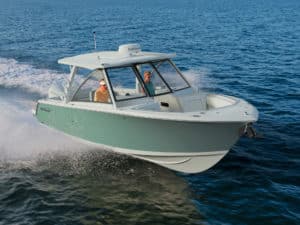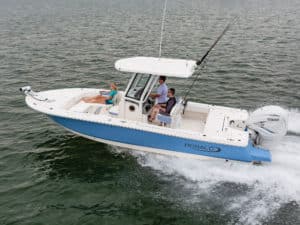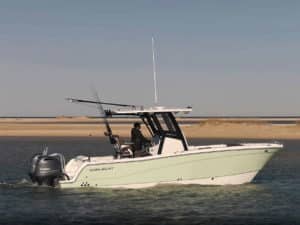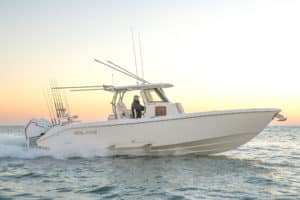Baha seems to sell more of its no-nonsense catamarans to charter operations in remote parts of the world than any other American cat builder. A ride on the 270 shows why it, too, may join its 34-foot sibling in places where seaworthiness and value for the dollar must be proven factors.
Performance
Florida’s Big Bend area around Steinhatchee requires you to go quite a few miles out to find deep water. On our way out in calm water, I discovered that the 270 doesn’t like running with its engines trimmed down. Like a child asked to do something it doesn’t like, the 270 mopes, drags its feet and resists the direction you want it to go. Trim those engines up and it’s like telling the child, “Oh, go ahead.” It lifts and skips across the water without a care in the world.
I regret I didn’t have 4- to 5-foot seas to really test the 270’s mettle. But other non-factory sources who’ve run this particular boat assure me that in a heavy sea, the King Cat holds its running attitude admirably. In other words, it runs fairly bow high, and when it launches off a wave and lands, that attitude remains pretty much the same, landing softly and stern first. Like the 34, it doesn’t like heading directly into a sea, but crack off just five or 10 degrees and the change in the ride can only be described as remarkable.
The King Cat remains flat in a turn with little or no heeling to the outside. In fact, the 270 will cut as hard and tight as you’re brave enough to turn the wheel. I was also surprised at how little speed bleeds off. Many cats drop the inside bow, bleed off speed and pivot. Not the 270 King Cat. One reason may be the very high tunnel compared to other popular cats.
Another comparison showed that the 270 exhibited more bow rise than many cats when you push the throttle forward, thanks to it being a planing hull rather than semi-displacement or displacement – both of which offer little or no bow rise at all.
Taking some party-boat wakes broadside while drifting proved how stable the 270 could be in a 3-foot swell drifting beam-to. Our trusty Johnson carbureted outboards rated at 200-hp each had no problem pushing the 270 in excess of 51 mph at 5,500 rpm. Cruising at 4,000 rpm turned 36 mph and 3,500 rpm a comfortable 29 mph. But those of you who prefer twin-engine insurance when running offshore will particularly appreciate the 270’s most impressive performance aspect. With one engine trimmed out of the water, the 270 gets up on plane in a matter of seconds and carries you home at 28 mph.
Fishing
One thing outboard catamarans do infinitely better than outboard monohulls is back down. The 270 allowed sensitive control in reverse even at almost 6 mph. It didn’t dig in at all. Interestingly, despite the widely set engines, the boat actually turns faster with throttle applied to the outboard engine (that’s the left engine when turning right) in forward and turned hard over. One engine in reverse and the other in forward doesn’t make the boat react anywhere nearly as quickly.
While you could easily fit a half-dozen rod holders across the back of the hardtop, they’re not a standard item. Adding those would nicely augment the four under and four in each gunwale. I’d also put cleats on each bow in addition to the centerline cleat, so that when bottom- or wreck-fishing, I could move the boat a reasonable distance laterally just by moving the tie-down point of the anchor line.
Due to the height of the tunnel, the Baha 270 has relatively high top sides and deck. So while resting your chest on the gunwale takes the stretch out of reaching the water’s surface, the gunwale in the aft end of the cockpit rises only to knee height. What you won’t ever feel shortchanged on is cockpit space. Throughout the line, I know of no company that offers as much cockpit space in each of its cats as Baha.
Design and Construction
Though our test boat had outboards, Baha’s 270 represents the only 27-foot cat available with inboard power. Serious offshore anglers should consider the 270 with a pair of high-output, small-footprint diesels with jackshafts and stern-drives. The engines last forever and fuel economy can’t be beat. Expect to pay in the mid-$80s for such a package.
Baha uses XL plywood as coring material in the transom and stringers. But before you sputter the marketing line about all-fiberglass construction, be aware that studies show plywood to be the strongest composite available. And Baha gives a lifetime guarantee against rot. Add to that the fact that the plywood in the transom and stringers gets totally encapsulated in isophthalic resin and fiberglass and the result is an incredibly strong core material. In addition, every Baha gets a barrier coat of vinylester resin to prevent osmotic blistering. Hull bottoms on the King Cat are solid fiberglass while the topsides consist of Nida-Core sandwich construction to lighten the weight and lower the center of gravity for greater stability – all without sacrificing strength.








